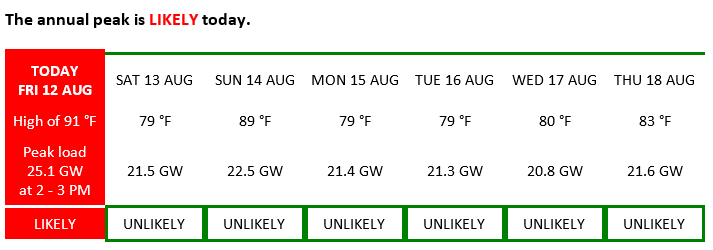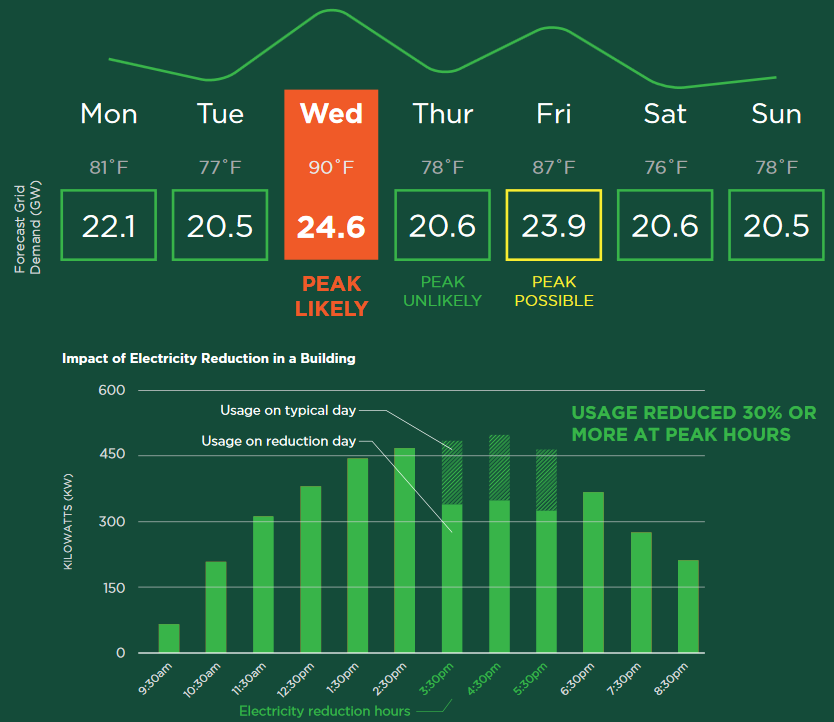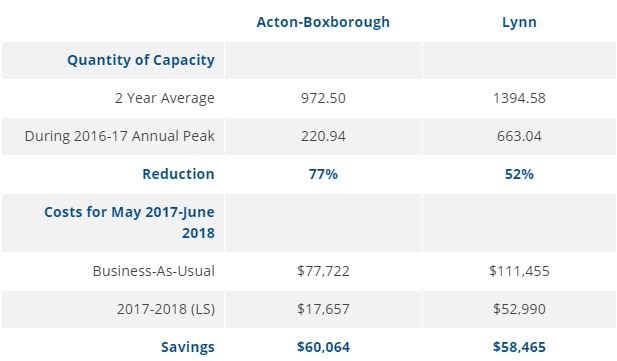Peak Demand Program
Photo Credit: AdobeStock_497816891
MAPC's Peak Demand Notification Program
Peak Demand Notifications will resume in June 2025.

Email [email protected] for more information.
Each morning from June to mid-September, MAPC sends out an email that assesses the risk that the annual peak could occur that day and, if so, at what time. The notifications also include an outlook for the next week so municipalities have time to plan ahead. MAPC develops this assessment by analyzing data provided by the grid operator, ISO-NE.
Interested in Peak Demand?
Peak Demand Management
Since 2015, MAPC has helped municipalities save hundreds of thousands of dollars from their largest facilities through peak demand management.
MAPC runs our own free Peak Electricity Demand Notification program for our municipalities to learn how to reduce demand and the costs and emissions associated with capacity charges. MAPC can also help connect you to other demand management opportunities offered by National Grid, Eversource, and ISO-New England (ISO-NE).
Who Have We Helped?
The following are examples of municipalities and school districts in the MAPC region that have participated in our program and are actively managing their demand:
Acton Boxborough Schools | Arlington | Bedford | Boston | Brookline | Burlington | Cambridge | Carlisle | Chelsea | Concord | Lexington | Lynn | Medford | Melrose | Natick | Newburyport | Newton | Quincy | Watertown | Winchester | Winthrop
What is Peak Demand?
Each year, the single hour in which the electric grid experiences its highest – or peak – demand, typically occurs in the summer. This annual peak tends to correlate with high temperatures and occurs in late afternoon when buildings are using the most electricity to power the air conditioning and other loads. Typically, a handful of other days each year will also have demand that comes close to the annual peak. Providing enough electricity to meet these relatively few peak days has important environmental and economic impacts:
Environmental Impact
During these times of high demand, our dirtier fuel sources (i.e. oil and inefficient natural gas) come online. Reducing demand during grid-wide peaks displaces comparatively more emissions than at other times by reducing the use of these high-emitting facilities.
Economic Cost
In order to ensure that there is enough electric “capacity” available on the grid to meet demand in future years, the grid operator ISO-New England (ISO-NE), has a program that pays energy generators if they meet future generation commitments. To make these payments, ISO-NE assesses a capacity charge, which is incorporated into your electricity supply rate (as opposed to the utility’s distribution rate). ISO-NE determines the quantity of capacity to charge your facility solely based on the demand in your facility during the annual peak hour on the grid. Given the right forethought, this provides municipalities the opportunity to save big by “load-shedding,” or reducing consumption, during the expected annual peak hour – sometimes as much as 30% of their bill.
Utilities also have to size their distribution systems to meet peak demand, and they are increasingly offering programs that can allow you to generate additional savings from managing peak demand (see below for the Stacking the Benefits section).

If you are new to peak demand management, we recommend our program as a great way to start. To begin, MAPC stresses the importance of developing a peak demand action plan to successfully and effectively run a peak demand program:
- Plan ahead of the summer
- Identify facilities to target (see below)
- Identify a champion who will manage the program
- Educate stakeholders such as town administrators, custodians, and facility managers for buy-in
- Identify all strategies for reducing demand relevant to your facilities (see below)
- Ensure stakeholders who have the responsibility to implement each strategy
- Determine your feedback strategy. Feedback is critical after each demand reduction event. Thank participants, get feedback, and seek ways to improve.
Facilities to Target
Applicability

Only accounts that have time-of-use meters can report the usage during the annual peak hour. These accounts can be identified by their rate:
National Grid: G3
Eversource: B3, B5, B7, G6, G8
Time-of-use meters typically only exist on the largest users of electricity in town, such as the high school, middle school, city or town hall, senior center, library, and wastewater treatment facility. Your supplier or broker can help you identify these accounts.
Actions to Reduce Load
To effectively reduce load, it is important to think ahead. Part of this is understanding where activities may be occurring in your facilities during or near the peak hour. If those activities will be affected, advanced communication is key. For facilities or areas of facilities that do not have activities, you may be able to take more drastic demand reduction measures.

Turn A/C set-points up at least a few degrees or turn off A/C altogether. Pre-cooling a building on a predicted peak demand day can help you keep building occupants more comfortable. Closing shades to minimize solar gain during the peak hour is also helpful.
Cost Savings in Action

The chart on the left shows some selected examples of capacity cost savings achieved by enrolling in MAPC’s program. As shown in the tables below, Acton-Boxborough schools reduced demand by 77% and Lynn 52% during the 2016 – 17 summer. This likely resulted in each municipality avoiding roughly $60,000 in capacity charges the following year.
Stacking the Benefits
More Opportunities, More Savings
When MAPC started our program back in 2015, we primarily focused on avoiding capacity costs (red bar). This was a great way to introduce many of our municipalities to the idea of managing peak demand to save money and lower emissions. Now, National Grid and Eversource have launched pilot programs that will also pay you for reducing demand (blue bar); as a side benefit, you will also likely get the red bar of avoided capacity costs through their programs too. Further, by participating in their programs, you can connect with providers that will help you participate in an ISO-NE program that can provide additional payments for reducing demand during grid emergencies, such as when a power plan unexpectedly goes offline (green bar). As a result, it is possible to “stack” the benefits and earn as much as $200 per KW. Please contact MAPC to learn how to enroll into these other opportunities.
National Grid: Connected Solutions Program
Eversource: Thermal storage, battery storage, software and control systems, active demand response
ISO-New England: Real Time Demand Response Program
Stacking the Benefits with Melrose
Melrose is a great example of a municipality that started in MAPC's peak electricity notification program before taking advantage of National Grid's Connected Solutions Program and ISO-NE Real Time Demand Response Program. In addition to its avoided capacity costs of reducing demand during the peak hour, Melrose earned roughly $4,000 from the National Grid Program as well as over $5,000 from the ISO-NE Program. The City used part of the funds to pay for a solar charging bench at one of its schools.
MAPC highly recommends to start with our program before enrolling into these other programs. MAPC's peak electricity demand notification program aims to coach municipalities to become successful players in load shedding. Once experienced, municipalities should then consider enrolling into these other opportunities and reap the additional benefits.

Resources
Watch
Webinar: Managing Peak Demand and Capacity Costs
We highly recommend watching our webinar to learn more about strategies to reduce demand and for more background on the program.
Read
Overview of MAPC, National Grid, Eversource, and ISO-New England's Demand Response Program
Mass Save Connected Solutions program information
Contact
Contact the Clean Energy Team ([email protected]) to learn more and sign up for peak demand notifications
